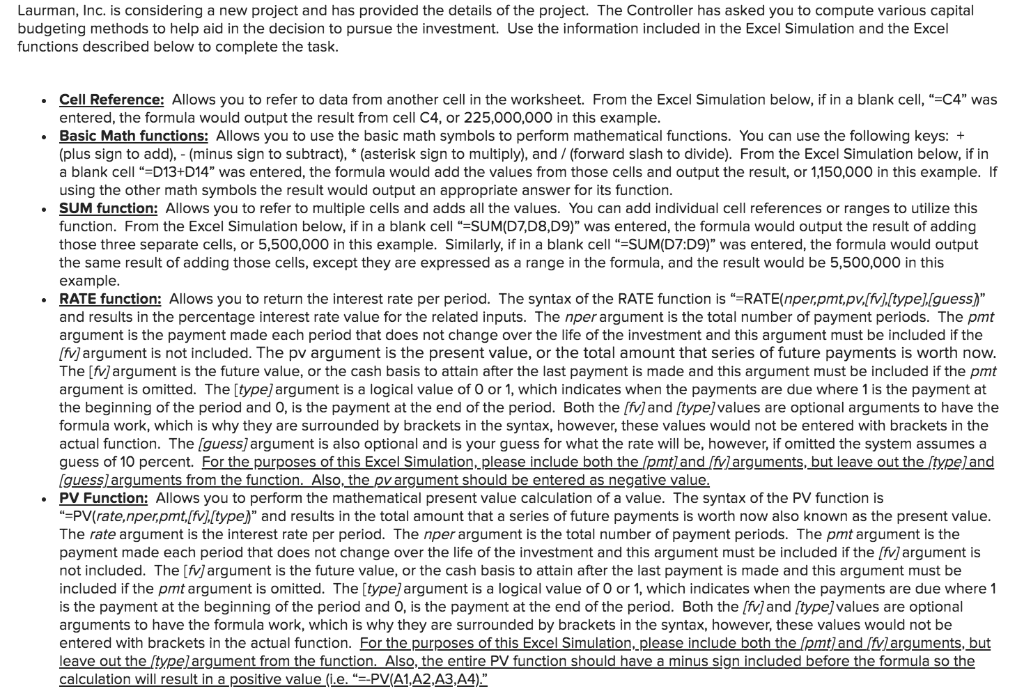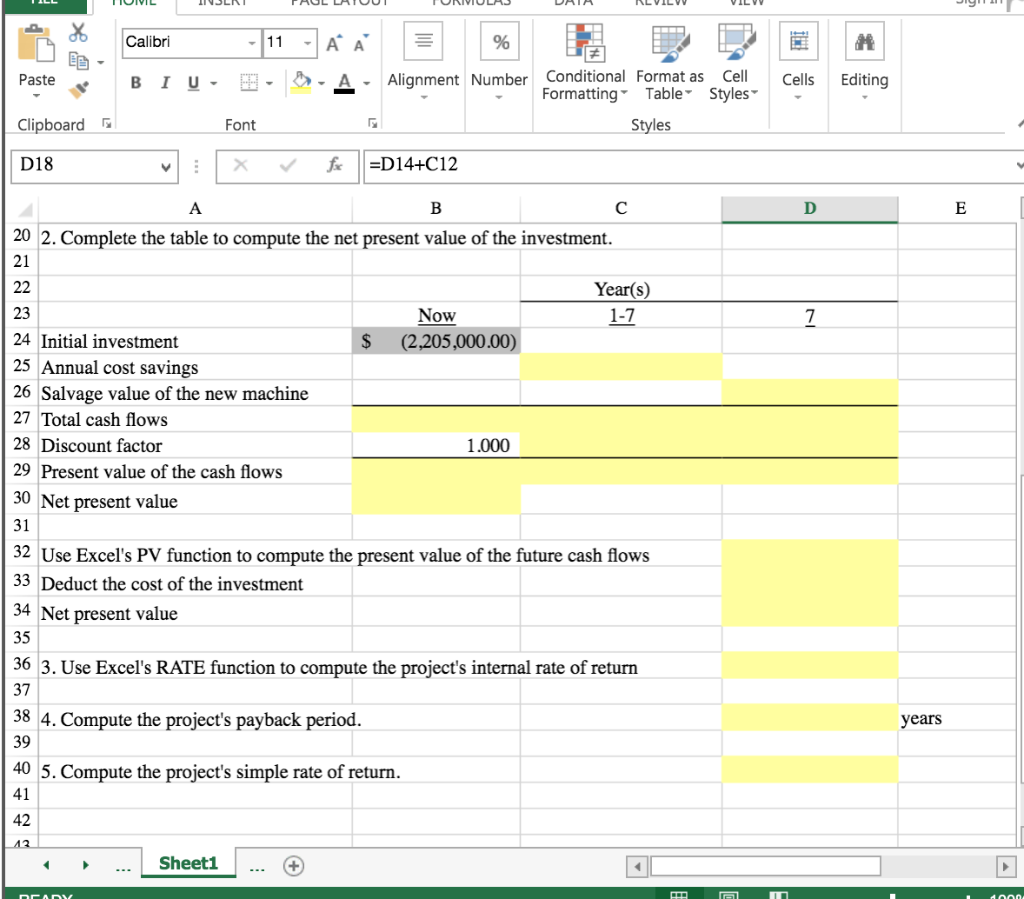

Laurman, Inc. is considering a new project and has provided the details of the project. The Controller has asked you to compute various capital budgeting methods to help aid in the decision to pursue the investment. Use the information included in the Excel Simulation and the Excel functions described below to complete the task. Cell Reference: Allows you to refer to data from another cell in the worksheet. From the Excel Simulation below, if in a blank cell,"-C4" was ed, the formula would output the ult from cell C4, or 225,000,000 in this amp Basic Math functions: Allows you to use the basic math symbols to perform mathemat I functions. You se the following keys: (plus sign to add), (minus sign to subtract), " (asterisk sign to multiply), and/ (forward slash to divide). From the Excel Simulation below, if in a blank cell -D13+D14" was entered, the formula would add the values from those cells and output the result, or 1150,000 in this example. If using the other math symbols the result would output an appropriate answer for its function. SUM function: Allows you to refer to multiple cells and adds all the values. You can add individual cell references or ranges to utilize this function. From the Excel Simulation below, if in a blank cell -SUM(D7,D8,D9)" was entered, the formula would output the result of adding those three separate cells, or 5,500,000 in this example. Similarly, if in a blank cell =SUM(D7:D9)" was entered, the formula would output the same result of adding those cells, except they are expressed as a range in the formula, and the result would be 5,500,000 in this example RATE function: Allows you to return the interest rate per period. The syntax of the RATE function is -RATE(nper,pmtpwnAypelguess)" and results in the percentage interest rate value for the related inputs. The nper argument is the total number of payment periods. The pmt argument is the payment made each period that does not change over the life of the investment and this argument must be included if the . argument is not included. The pv argument is the present value, or the total amount that series of future payments is worth now. The [fvjargument is the future value, or the cash basis to attain after the last payment is made and this argument must be included if the pmt argument is omitted. The [type]argument is a logical value of O or 1, which indicates when the payments are due where 1 is the payment at the beginning of the period and 0, is the payment at the end of the period. Both the [fv]and [type]values are optional arguments to have the ets in the rmula work, which is why they are s actual functio gu guesslarguments from the function, Also, the pvargument should be entered as negative value. PV Functi "-PV(rate,nper,pmt,[fv),ftype)" and results in the total amount that a seri ed by brackets in the syntax, however, the s would not be entered with br he [guess7argument is also op nd is your guess for what the rate will be, however, if omitted the system assumes a th the spmt]andfMarguments, but leave out theltype]and of 10 For the pur Excel Simu pe Allows syntax of the PV functio form the mathema pr f future payments is worth now al nown as the present v he pmt argument is the the terest rate per period. The nper argument is the total number of payment perio payment made each period that does not change over the life of the investment and this argument must be included if the [fvjargument is not included. The [fvjargument is the future value, or the cash basis to attain after the last payment is made and this argument must be included if the pmt argument is omitted. The [type/argument is a logical value of O or 1, which indicates when the payments are due where 1 is the payment at the beginning of the period and O, is the payment at the end of the period. Both the [fvjand [type]values are optional arguments to have the formula work, which is why they are surrounded by brackets in the syntax, however, these values would not be entered with brackets in the actual function. For the purposes of this Excel Simulation, please include both the spmt andffvarguments, but leave out the ftypeargument from the function. Also, the entire PV function should have a minus sign included before the formula so the calculation will result in a positive value (i.e. "-PV(A1A2,A3,A4) 11A A Cells Editing -A-Alignment Number Conditional Format as Cell Paste Formatting Ta Styles- Styles Clipboard Font D18 20 2. Complete the table to compute the net present value of the investment 21 Year(s) 1-7 23 24 Initial investment 25 Annual cost savings 26 Salvage value of the new machine 27 Total cash flow 28 Discount factor 29 Present value of the cash flows 30 Net present value 31 32 Use Excel's PV function to compute the present value of the future cash flows 33 Deduct the cost of the investment 34 Net present value 35 36 3. Use Excel's RATE function to compute the project's internal rate of return 37 38 4. Compute the project's payback period 39 40 5. Compute the project's simple rate of return 41 42 Now S (2,205,000.00) 1.000 years ... t ....Sheet1 Laurman, Inc. is considering a new project and has provided the details of the project. The Controller has asked you to compute various capital budgeting methods to help aid in the decision to pursue the investment. Use the information included in the Excel Simulation and the Excel functions described below to complete the task. Cell Reference: Allows you to refer to data from another cell in the worksheet. From the Excel Simulation below, if in a blank cell,"-C4" was ed, the formula would output the ult from cell C4, or 225,000,000 in this amp Basic Math functions: Allows you to use the basic math symbols to perform mathemat I functions. You se the following keys: (plus sign to add), (minus sign to subtract), " (asterisk sign to multiply), and/ (forward slash to divide). From the Excel Simulation below, if in a blank cell -D13+D14" was entered, the formula would add the values from those cells and output the result, or 1150,000 in this example. If using the other math symbols the result would output an appropriate answer for its function. SUM function: Allows you to refer to multiple cells and adds all the values. You can add individual cell references or ranges to utilize this function. From the Excel Simulation below, if in a blank cell -SUM(D7,D8,D9)" was entered, the formula would output the result of adding those three separate cells, or 5,500,000 in this example. Similarly, if in a blank cell =SUM(D7:D9)" was entered, the formula would output the same result of adding those cells, except they are expressed as a range in the formula, and the result would be 5,500,000 in this example RATE function: Allows you to return the interest rate per period. The syntax of the RATE function is -RATE(nper,pmtpwnAypelguess)" and results in the percentage interest rate value for the related inputs. The nper argument is the total number of payment periods. The pmt argument is the payment made each period that does not change over the life of the investment and this argument must be included if the . argument is not included. The pv argument is the present value, or the total amount that series of future payments is worth now. The [fvjargument is the future value, or the cash basis to attain after the last payment is made and this argument must be included if the pmt argument is omitted. The [type]argument is a logical value of O or 1, which indicates when the payments are due where 1 is the payment at the beginning of the period and 0, is the payment at the end of the period. Both the [fv]and [type]values are optional arguments to have the ets in the rmula work, which is why they are s actual functio gu guesslarguments from the function, Also, the pvargument should be entered as negative value. PV Functi "-PV(rate,nper,pmt,[fv),ftype)" and results in the total amount that a seri ed by brackets in the syntax, however, the s would not be entered with br he [guess7argument is also op nd is your guess for what the rate will be, however, if omitted the system assumes a th the spmt]andfMarguments, but leave out theltype]and of 10 For the pur Excel Simu pe Allows syntax of the PV functio form the mathema pr f future payments is worth now al nown as the present v he pmt argument is the the terest rate per period. The nper argument is the total number of payment perio payment made each period that does not change over the life of the investment and this argument must be included if the [fvjargument is not included. The [fvjargument is the future value, or the cash basis to attain after the last payment is made and this argument must be included if the pmt argument is omitted. The [type/argument is a logical value of O or 1, which indicates when the payments are due where 1 is the payment at the beginning of the period and O, is the payment at the end of the period. Both the [fvjand [type]values are optional arguments to have the formula work, which is why they are surrounded by brackets in the syntax, however, these values would not be entered with brackets in the actual function. For the purposes of this Excel Simulation, please include both the spmt andffvarguments, but leave out the ftypeargument from the function. Also, the entire PV function should have a minus sign included before the formula so the calculation will result in a positive value (i.e. "-PV(A1A2,A3,A4) 11A A Cells Editing -A-Alignment Number Conditional Format as Cell Paste Formatting Ta Styles- Styles Clipboard Font D18 20 2. Complete the table to compute the net present value of the investment 21 Year(s) 1-7 23 24 Initial investment 25 Annual cost savings 26 Salvage value of the new machine 27 Total cash flow 28 Discount factor 29 Present value of the cash flows 30 Net present value 31 32 Use Excel's PV function to compute the present value of the future cash flows 33 Deduct the cost of the investment 34 Net present value 35 36 3. Use Excel's RATE function to compute the project's internal rate of return 37 38 4. Compute the project's payback period 39 40 5. Compute the project's simple rate of return 41 42 Now S (2,205,000.00) 1.000 years ... t ....Sheet1








